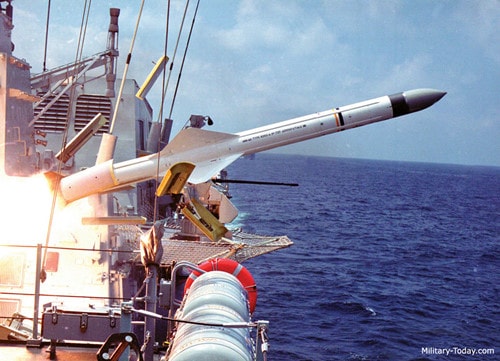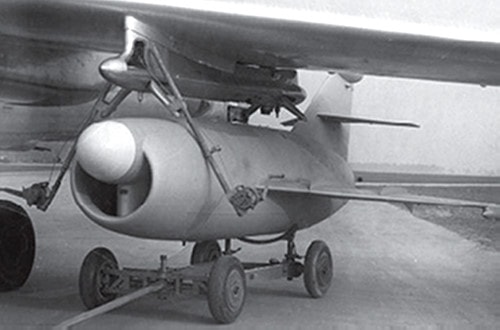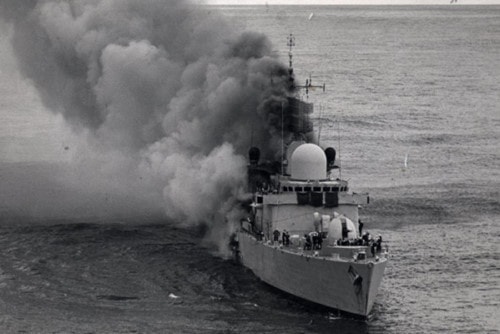Exocet Anti-Ship Missile: British Naval Conqueror
The effectiveness of Exocet in combat over the past few decades has confirmed that no type of warship is safe from anti-ship missiles at sea.
Anti-ship missiles (ASMs) began to appear during World War II. The Germans led the way with the Henschel Hs 293 and Kramer XL, commonly known as the Fritz-X. The Hs 293 was essentially a bomb with wings and a tail, short wings, and a rocket engine. Once dropped from an aircraft, the rocket engine accelerated the bomb to about 900 km/h and it was guided to its target by a bomb squad using a radio remote control.
Both of these weapons were used in World War II on a small scale. Under ideal conditions, they had enough destructive power to sink enemy ships and were quite accurate.
Out of sight
|
| The first anti-ship missile produced by the Soviet Union looked like a miniature jet fighter. Photo source: Was |
The Soviet Union pioneered both air- and ground-launched ASMs. Their first was the AS-1 Kennel, a turbojet-powered cruise missile with a range of up to 172 km, guided by a combination of autopilot, radar beam tracking, and semi-active radar homing.
Soon after, the SS-N-2 Styx missile was introduced, which used terminal active radar guidance and radio command control. It became the first post-World War II anti-ship missile to be deployed in combat, when Egyptian missile boats sank the Israeli destroyer Etlat in 1967.
By this time, the rest of the world had caught up with the Soviet Union. NATO countries had produced increasingly sophisticated ASMs, including the Exocet.
The Exocet anti-ship missile is a French-developed anti-ship weapon that entered service with the French Navy in 1975. Its immediate strength was its versatility - by 1979 it could be launched from land, sea, or air with a range of about 50 km.
|
| British ship HMS Sheffield was hit by an Exocet missile. Photo source: Wiki |
Like many other modern ASMs,Exocet missileThe missile approaches its target at “sea-skimming” altitude, reducing the chance of being detected by enemy radar. An active radar seeker guides the missile to its target over the last 12-15 km of its flight path – during which time the altitude can drop to as low as 3 meters above sea level. A 165 kg high explosive/fragmentation warhead delivers the devastating effect, with a timed impact fuse allowing the missile to penetrate the interior of the warship before detonating.
Falklands War
A shocking demonstration of the effectiveness of the Exocet anti-ship missile came in 1982, when the British deployed a sizeable Naval Rapid Reaction Force to retake the Flakland Islands from Argentina.
On May 4, an Argentine Super Etendard shot down an Exocet missile that hit the Type 42 destroyer HMS Sheffield. The missile penetrated the Sheffield mid-ship, just above the waterline.
Although the warhead failed to explode, the impact killed 20 men and set the ship on fire beyond repair, sinking five days later. Two weeks later, on May 25, two more Exocets hit the British container ship Atlantic Conveyor, which was carrying helicopters and supplies for the land operation. That ship also sank five days later.
 |
| Exocet missile, the most fearsome anti-ship missile ever built in Europe. Photo source: Military |
Then, under pressure from London, France was forced to halt the transfer of Exocet missiles to Argentina without further British ships being attacked by the deadly weapon. During the 1980s, more than 100 Exocet missiles were fired on battlefields around the world, mainly by Iraq against Iranian ships and oil rigs during the war between the two countries. But two Exocets also damaged the US ship USS Stark in 1987.
This made Exocet one of the most successful anti-ship missiles since World War II, and it also proved that a few cheap missiles could change the outcome of an entire campaign by simply sinking strategic enemy warships.
Video: Close-up of the Exocet missile attack on the British ship HMS Sheffield.



